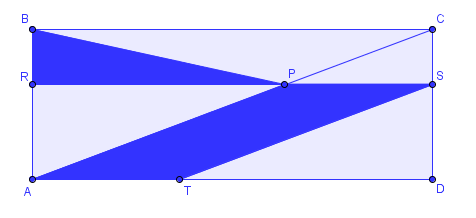A New Flag?
A B C D is a rectangle and P is any point on A C (except A and C ). Through P is plotted a line parallel to B C which cuts A B and D C at R and S , respectively. Also, through S is plotted a line parallel to A C which cuts A D at T .
Find Area P R B Area T S P A .

The answer is 2.0.
This section requires Javascript.
You are seeing this because something didn't load right. We suggest you, (a) try
refreshing the page, (b) enabling javascript if it is disabled on your browser and,
finally, (c)
loading the
non-javascript version of this page
. We're sorry about the hassle.
3 solutions
Nice solution! So for any point P on AC the solution is true, isn't it? No my question is what would happen if P converges to C or A?
Log in to reply
Degenerates figures
Log in to reply
I am not clear by your answer!
Log in to reply
@Mahabubul Islam – If P lies on C , then △ B P R will be equal to line B C (when P lies on △ B P R is equal to A B ) and T S P A will be equal to A C . So both figures will be a line and its area 0 , ∴ the ratio will be indeterminate.
=sd at/(0.5rp rb) , if p middle ac, rp= at, and sd=rb >>>>>>> soultion is 2
Slightly implicit solution: from the formulation, deduce/infer the answer does not depend on the lengths of the objects. For the particular case of ABCD as a square and P in its center, the answer is quite intuitive. Generalise.
How did you get the generalization?
Log in to reply
I meant "the answer for a particular case is probably right for every case", so I just reduced the problem to the case where A B = A D and A P = P C and figured it was the general answer.
Relevant wiki: Length and Area - Composite Figures
Area ∣ T S P A ∣ Area ∣ P R B ∣ = = ( K M ) ( 1 − K ) N = K ( 1 − K ) M N 2 1 K N ( 1 − k ) M = 2 1 K ( 1 − K ) M N
Taking their ratio gives the desired answer of 2 .